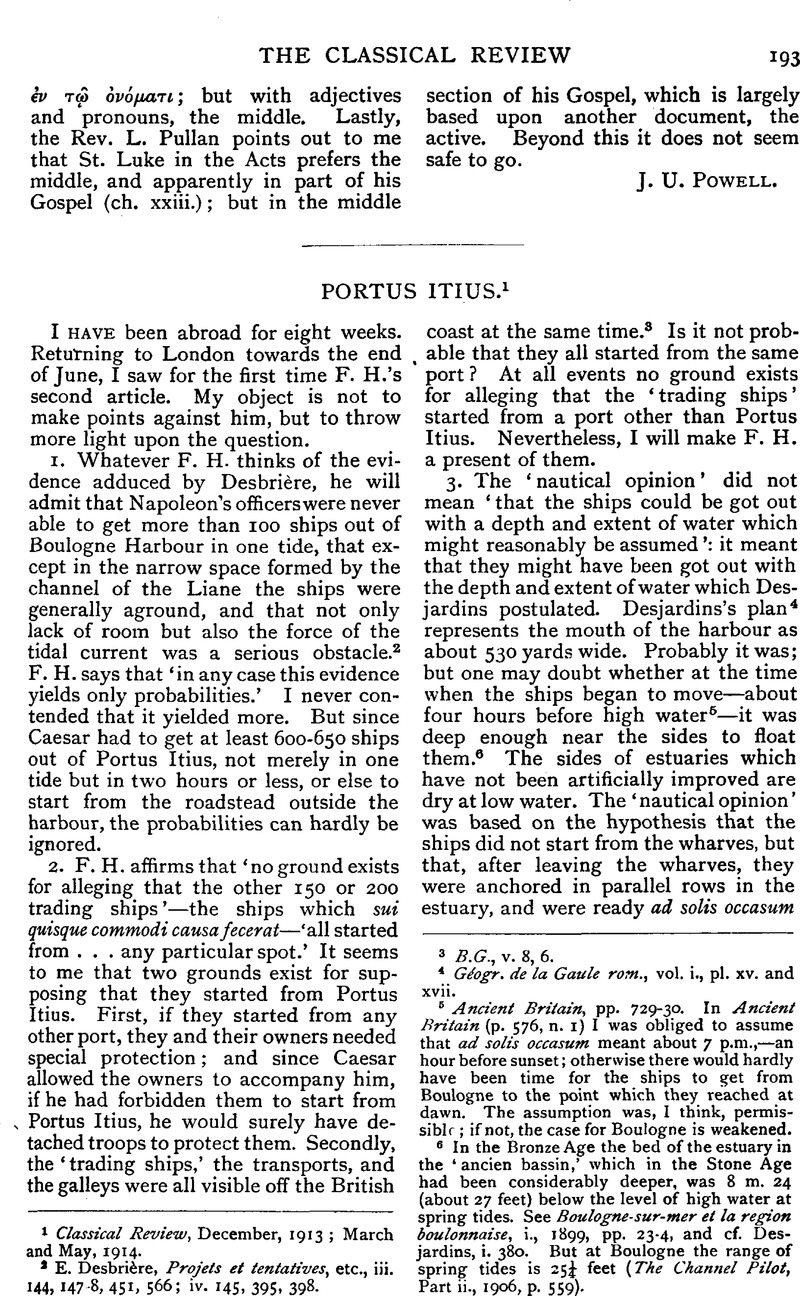No CrossRef data available.

page 193 note 2 E. Desbrière, Projets et tentatives, etc., iii. 144, 147–8, 451, 566; iv. 145, 395, 398.
page 193 note 3 B.G., v. 8, 6.
page 193 note 4 Géogr. de la Gaule rom., vol. i., pl. xv. and xvii.
page 193 note 5 Ancient Britain, pp. 729–30. In Ancient Britain (p. 576, n. 1) I was obliged to assume that ad solis occasum meant about 7 p.m.,—an hour before sunset; otherwise there would hardly have been time for the ships to get from Boulogne to the point which they reached at dawn. The assumption was, I think, permissible ; if not, the case for Boulogne is weakened.
page 193 note 6 In the Bronze Age the bed of the estuary in the ‘ancien bassin,’ which in the Stone Age had been considerably deeper, was 8 m. 24 (about 27 feet) below the level of high water at spring tides. See Boulogne-sur-mer et la region boulonnaise, i., 1899, pp. 23–4, and cf. Desjardins, i. 380. But at Boulogne the range of spring tides is 25¼ feet (The Channel Pilot, Part ii., 1906, p. 559).
page 194 note 1 B.G., v. 2, 2; 5, 2.
page 194 note 2 The transports could hardly have been smaller than Napoleon's smallest vessels, which were 60 feet long. See Caesar's Conquest of Gaul, p. 436, n. 6, and B.G., v. 23, 5.
page 194 note 3 See the plan in Desbrière's fourth vol., p. 400.
page 194 note 4 So he told me in 1911.
page 194 note 5 The best plan would have been this. Suppose that the ships in the column furthest from the wharf, reckoned from the ship nearest the mouth of the harbour, were numbered 1, 2, 3… The crews of 10, 20, 30, etc., would have simultaneously cast off the hawsers, and begun to row diagonally across the stream. At the right moment 9, 19, 29, etc., would have followed suit. Thus ultimately 10, 9, 8 … I would have been rowing abreast, followed by 20, 19, 18, etc. Then the next column would have begun to move, and so on. Remember that the current was of course strongest in mid-stream, and that there are eddies at the mouth of the harbour.
page 194 note 6 B.G., v. 1, I.
page 194 note 7 Probably after; for their draught was greater, and when the transports had gone there would have been more water.
page 194 note 8 Cf. B.G., iv. 23, 2 with § 4.
page 194 note 9 Desbrière, iii. 144.
page 194 note 10 See Caesar's Conquest of Gaul, 1911, pp. 436, 438.
page 195 note 1 Fifth ed., 1886, p. 258.
page 195 note 2 The Soldier's Pocket-Book, 1886, pp. 73, 77.
page 195 note 3 B.G., v. 8, 4.
page 195 note 4 The author of the ‘nautical opinion’ owns a ketch, 57 feet long, which he sails with the help of two men.
page 195 note 5 Hist, de Jules César, ii. 323.
page 195 note 6 The Soldier's Pocket-Book, p. 95.
page 195 note 7 At Alexandria Caesar sunk wells with satisfactory results (Bell. Alex., 8, 1; 9, 1–2) ; but to do so at Wissant would have been unnecessary.
page 195 note 8 The Soldier's Pockei-Book, p. 73.
page 196 note 1 The Soldier's Pocket-Book, p. 78.
page 196 note 2 Cf. Desbrière, iii. 162, with Geol. Mag., 1866, pp. 113–4.